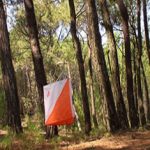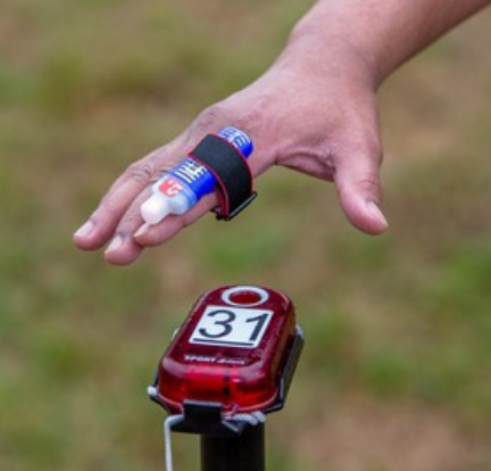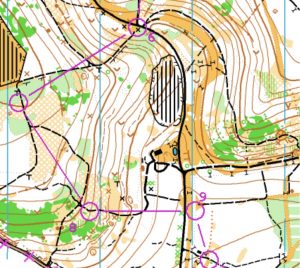
Getting started in the world of orienteering is very easy and you need no special equipment to attend your first event – just a sense of adventure! This guide will tell you everything you need to get started.
Please join us. Once you have been to one of our events, we hope you will have had a great time and will want to come again. If so, we would encourage you to join us (or, if you don’t live nearby, your local club). You will benefit from member discounts and a range of other benefits – click here for details.
What is orienteering?
It’s a race with no set route – you have to find your own way between a series of checkpoints, using a detailed orienteering map. The checkpoints are marked by flags on the ground and the challenge is to decide your own route around the course, using your map. Will your checkpoints be along paths, or hidden on earth banks, ditches or bushes?
At each event, there are longer courses for runners plus shorter junior and family courses. Events traditionally take place in woods and forests, but over recent years there have been more urban and shorter (“sprint” events) around university campuses. Help is always available and it’s a great sport for all ages and abilities, from under 10s to 80 plus!
You decide how serious and competitive you want to be – at an elite level, orienteering is a competitive running sport that improves all levels of fitness and stretches the body and the mind.
It’s perfectly ok to walk around a course as a family and enjoy the scenery
So what do you do?

To record your progress around the course you use a small electronic timing chip that you take around the course with you. At each control site there is a small box which records on your chip what time you passed through. After you finish you are then able to see what your total time was and how long you took for every leg of the course. Overall results will be displayed on the organising club’s website later that day.
Although orienteering is a competitive sport, many people come just for the challenge of completing the course and enjoying the scenery. Thames Valley Orienteering Club is the local club for Oxfordshire and Bucks.
Where can I have a go?
We have around 250 members and we organise around 30 events a year, including our monthly Saturday Series aimed at juniors and newcomers, larger regional and national events for experienced orienteers competing in national leagues (and newcomers too), plus various training sessions and activities including our summer evening series.
Why not come along to one of our Saturday Series events to experience the excitement of a proper orienteering event. We have coaches and experienced orienteers available to get you started at your first event and there are always plenty of people trying the sport for the first time.
The map

Orienteering maps are very detailed and at scales much larger than OS maps; they are commonly at 1:10000, which is five times the scale of a typical OS map. Black is used for manmade features such as buildings and paths. Brown shows landforms such as contours and ditches. Blue shows water features such as ponds and streams. White and Green show the density of woodland and the extent to which it is runnable. Open runnable woodland is shown as white, with darker shades of green showing more wooded areas. Yellow is used for open areas. Maps will have a legend and the symbols are easy to recognise after a few events.
At an event
The first thing to do is register at the registration tent. Plenty of help will be available to help you choose a suitable course. Most courses are “colour-coded”, where the colour represents the length and navigational difficulty. White, Yellow and Orange courses are normally recommended for newcomers, or Light Green if you’re confident. The course length is the straight-line distance between the controls and you will run/walk quite a bit further than this, depending on the route you choose between the controls.
Typical courses, who they are aimed at and typical lengths:
| White | The easiest course, with controls on paths | Children, family groups | 1.0-1.5km |
| Yellow | Fairly easy, uses linear features like paths & streams | Newcomers, children, families | 1.5-2.0km |
| Orange | More challenging -use of compass & route choice | Adult newcomers, children, families | 2.5-3.5km |
| Red | Similar difficulty as orange. Often not available – although we try to offer this course in our Saturday Series events. | Adult newcomers | 3.5 – 7.0km |
| Light Green | Challenging -uses contours and more route choices | Improvers and experienced orienteers | 2.5-3.5km |
| Green | Very challenging & shorter -lots of route choice | Experienced orienteers | 3.5-5.0km |
| Blue | Very challenging & longer -lots of route choice | Experienced orienteers | 5.0-7.0km |
| Brown | Very challenging & long -lots of route choice | Experienced orienteers | 7.5-10km |
When you register at an event, you will be given your electronic timing chip (“SI card”). You need to touch this against each control point that you visit and it will record your progress around the course.
Then make your way to the Start, where you will head off into the woods on your course – everyone starts at staggered intervals, and you can normally start between 10.30am and midday (some events do vary).
When you finish your course, the SI card will be downloaded and you will receive a printout of your split times. You must always go to the download point, even if you don’t finish, so that the organisers know you are not still out in the forest.
What next? Check out our next Saturday Series events and come along to have a go!
There are also several permanent orienteering courses across Oxfordshire and Bucks, including at Shotover Country Park and University Parks in Oxford. These are a great way to get started, at your leisure.
British Orienteering, the national body for the sport, has more information for newcomers here.
And do join us. You will benefit from member discounts and a range of other benefits – click here for details.
Video Tutorials
South London Orienteers (SLOW) have produced a series of eight videos showing different techniques used in orienteering. The videos are presented by different athletes from the GB Orienteering team and filmed in different locations. This first one is a newcomer’s guide.
See the full set of videos on the SLOW YouTube channel.